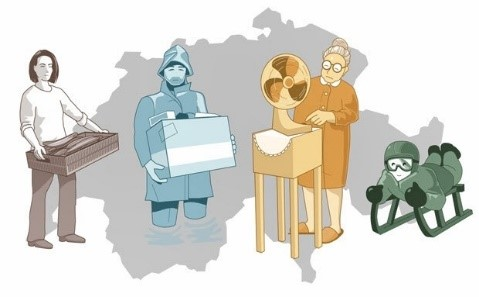The Swiss CH2018 Climate Change Scenarios describe how the climate may change nationwide by the middle of this century and beyond, both with and without increased mitigation measures. They form the cornerstone of the federal government's strategy for adaptation to climate change. The new cantonal climate scenarios are based on CH2018 and contain data on past climate change and the climate future of each individual canton.
To this end, fact sheets were created for each canton as well as Liechtenstein, and canton-specific data were added to the CH2018 web atlas. This information will serve as a guide and ensure uniform use of the CH2018 scenarios in all cantons. "Thanks to the cantonal climate scenarios, the Canton of Ticino can hone the way it adjusts and adapts to climate change," explains Roland David, president of the cantonal natural hazard commission. Inter alia, the online web atlas contains interactive and downloadable graphs of various emission scenarios, time periods and variables.
Here are some examples of the ways in which climate change could impact individual cantons:
1. Dry summers
In the long term, all cantons will see a decline in the mean amount of precipitation in summer. The frequency of precipitation will also change, with summers seeing even longer precipitation-free periods. Without climate mitigation measures, by around the middle of the century such periods will last on average 1.4 days longer in Buchs (Aargau) than they do today, while Sion (Valais) will go on average 2.1 days longer without precipitation.
2. More hot days
Maximum temperatures are rising faster than mean temperatures. In the future, the hottest summer days will be between 2 and 5.5° C warmer than they are today, with record-breaking summers like those of 2003 and 2018 potentially becoming the norm. Heatwaves will become more frequent and also more extreme, with heat stress at its highest in urban areas at low altitudes. For example, without climate change mitigation, the lower-lying areas of the Cantons of Zurich, Geneva and Ticino could see three to four times as many hot days by 2060 as they do today.
3. Heavy precipitation
Heavy precipitation events are likely to become significantly more frequent and intense in the future than they are today. This is the case for all seasons, but particularly for winter.. Without climate change mitigation, the heaviest daily precipitation in winter could increase by 7% on average in Aadorf (Thurgau) by 2060. The increase could be even greater in other regions, such as Zollikofen (Bern) and Lugano (Ticino), which could see increases of around 9% on average.
4. Snow-scarce winters
Winters in the middle of the century will be significantly warmer than they are today. Though there will be more precipitation, higher temperatures mean that it will tend to fall as rain rather than snow. In the Canton of Graubünden, for instance, the number of days with fresh snow will decrease significantly at all elevations. By 2060, elevations between 1,600 and 2,000 m above sea level will see around 20 fewer days with fresh snow without climate mitigation measures and 14 fewer days with fresh snow on average if such measures are implemented.


